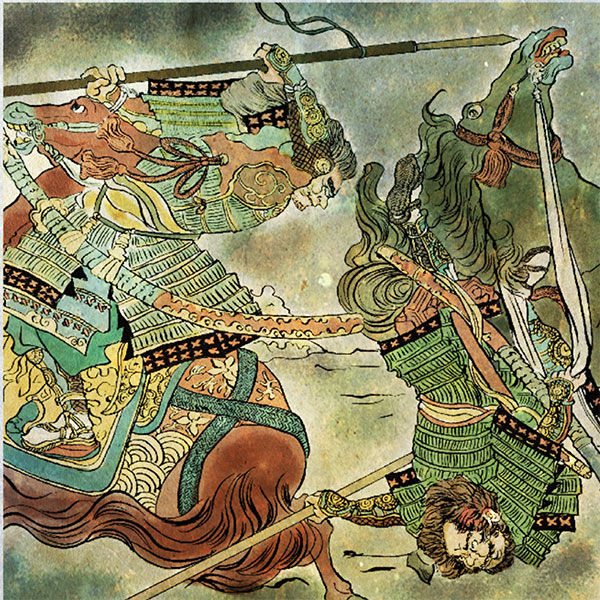- Oka domainThere was never a transfer of the castle lord.
- The Oka Domain was a domain that ruled the area of present-day Oaza Takeda City, Takeda City, Oita Prefecture. Ishidaka is the largest domain in Bungo, and Hidenari Nakagawa, the second son of Kiyohide Nakagawa, who was a subordinate of Toyotomi Hideyoshi, became the first lord, making it a rare domain that never changed country until the Meiji Restoration.

Oka CastleTakeda City, Oita Prefecture
- spring
- summer
- autumn
- winter
- TOP
- Kyushu
- Oita Prefecture
- Oka Castle
| Other name | Gagyu Castle, Bungo Takeda Castle |
|---|---|
| castle construction | 1185 |
| address | 2889 Takeda, Takeda City, Oita Prefecture |
| telephone number | 0974-63-1541 |
| Opening hours | 9:00-17:00 |
| closing day | December 31st - January 3rd |
| Admission fee | General 300 yen / Elementary and junior high school students 150 yen |
- Access to Oka Castle
- About 5 minutes by bus from JR “Bungo Takeda” station
HISTORYOka Castle was famous as an impregnable castle.
Oka Castle is a mountain castle located in Oaza Takeda City, Takeda City, Oita Prefecture. It was built on the summit of Mt. Tenjin, and was known as an impregnable and strong castle with other names such as ``Gagyujo'' and ``Bungo Takedajo.'' It is also known that composer Rentaro Taki found the inspiration for his famous song ``Kojo no Tsuki'' at the castle ruins. Let's unravel the history of Oka Castle, which has many such anecdotes.
- There is a legend that the castle was built to visit Minamoto no Yoshitsune.
- Legend has it that Oka Castle was built in 1185 by Ogata Koreyoshi, a vassal of Taira no Shigemori, to welcome Minamoto no Yoshitsune, who had been chased by Minamoto no Yoritomo. After the fall of the Heike clan, Minamoto no Yoshitsune came into conflict with his older brother, Minamoto no Yoritomo, and once tried to escape to Kyushu. However, he was thwarted by the storm, and this time he turned to the Oshu Fujiwara clan and headed to Tohoku. If Minamoto no Yoshitsune had entered Oka Castle, it is easy to imagine that there might have been a future where Minamoto no Yoshitsune conquered Kyushu, but research has now revealed that Oku Castle began to be built around the 14th century. I am.
- The Battle of Toyosatsu, which was famous as an impregnable castle
- Oka Castle's name suddenly became famous during the battle with the Shimazu clan that occurred in 1586. This battle, now known as the Toyosatsu Battle (Tensho no Yaku, Tensho no War), was fought between the Otomo clan of Bungo Province and the Shimazu clan, who aimed to subdue Satsuma, Osumi, and Hyuga provinces and unify Kyushu. It was held between 1900 and 2000, and it also served as an opportunity for Toyotomi Hideyoshi to pacify Kyushu. The lord of the castle at the time was Shinji Shiga, who was only 20 years old, and he barricaded himself in Oka Castle with just 1,500 soldiers and defeated the 37,000-strong Shimazu army. Also, in the decisive battle of Onigajo that broke out later, he won with 500 soldiers against the thousands of Yoshihiro Shimazu. It is recorded that Hideyoshi Toyotomi gave 1,000 koku of land to Hita City, Oita Prefecture in recognition of his fighting style. By the way, Shinji Shiga was a Christian with the baptismal name of Don Paul, which later became one of the reasons why he was shunned by his lord, Yoshimatsu Otomo, the eldest son of Sorin Otomo. Furthermore, at this time, Oka Castle had not yet built the stone walls that still exist today, and the main defense was earthworks and dry moats.
- Oka Castle from the end of the Sengoku period to the Edo period
- The stone walls of Oka Castle that still exist today were built in 1594. The previous year, in 1593, Yoshimune Otomo was accused by Hideyoshi of withdrawing from Hozan during the Bunroku War, and his territory was confiscated, and his vassal Shinji Shiga also left Oka Castle. It will be. By the way, after leaving the castle, Chikaji Shiga served Hachisuka Iemasa, Fukushima Masanori, and Mori Terumoto, and also participated in the Battle of Sekigahara, living a long life of 95 years. After Shinji Shiga left the castle, a man named Hidenari Nakagawa took his place as lord. He was the second son of Kiyohide Nakagawa, who served Toyotomi Hideyoshi and was active in the battles of Yamazaki and Shizugatake. Furthermore, Kiyohide Nakagawa was a cousin of Ukon Takayama, a Christian daimyo in Settsu Province, and Hidenari Nakagawa himself was also a Christian. Hidenari Nakagawa spent three years extensively renovating Oka Castle. The buildings of Oka Castle were demolished after the Meiji Restoration, and now only the stone walls remain. However, the stone walls made using the welded tuff of Mt. Aso use a variety of techniques, including field-cutting, uchikomi-gi, and kirikomi-gi, making them a wonderful structure that looks just like a stone wall fair. In addition, the stones are piled in random piles, cloth piles, valley piles, wooden blocks piles, etc., so it is worth seeing. In addition, Ote-michi has "kamaboko stones" that cannot be seen in other castles, and you can feel Hidenari Nakagawa's aesthetic sense and his unique commitment. In addition, Tsuruemon Ishida and Rokurobe Miyake were involved in the territorial design, and Kin'emon Yamagishi was involved in the construction of the stone walls, and the main keep, Ninomaru, Sannomaru Palace, and turret were built on Tenjinyama on the west side of the castle area built by the Shiga clan. The west side of the castle was expanded and a group of residences of senior vassals were established.
Since the Nakagawa clan belonged to the Eastern Army at Sekigahara, their territory was relieved, and even after the establishment of the Edo Shogunate, they continued to serve as the lord of Oka Castle. In the early Edo period, improvements were made to the Shimizu Gate and the construction of the Nishinomaru castle, and Oka Castle transformed from a castle used for war to a castle that served as the ``han's office.'' Because Oka Castle is built on a bedrock plateau, it is susceptible to damage from typhoons, earthquakes, and fires, and in 1771, most of the castle, including the Honmaru, Nishinomaru, and the Imperial Mausoleum, were destroyed. It is being hit by a huge fire. - Oka Castle after the Meiji period
- In the Meiji period, all buildings at Oka Castle were demolished except for the stone walls due to the Castle Abandonment Ordinance. In 1936, it was designated as a national historic site as ``Oka Castle Ruins.'' By the way, there is a statue of the composer Rentaro Taki at the Oka Castle ruins, but this is because Mr. Taki was born into a family of senior samurai who served as chief retainers of the Oka clan, and he spent his childhood in Taketa City. It comes from having spent time in One of Rentaro Taki's most famous songs, ``Kojo no Tsuki,'' is said to have been composed using the motifs of multiple castle ruins, including Oka Castle. The current Oka Castle ruins, known as Oka Castle Park, have been designated as one of Japan's top 100 cherry blossom spots, Japan's 100 most beautiful moons, and Japan's 100 best castles. It is crowded with tourists every year who come to admire the cherry blossoms in spring and the autumn leaves and moon in autumn.
- summary
- Oka Castle became the stage of an important battle related to the unification of Kyushu, and a dramatic battle unfolded in which a small number of troops defeated a large number. Today, Oka Castle is a tourist spot famous for cherry blossoms, autumn leaves, and the moon, and at the same time, it is also a historical site with stone walls decorated with various techniques. For those with walking disabilities, there is also a ``castle bus'' running from the Okajo tollgate to the east and middle partitions within the castle.
Read about incidents related to Okajo
- Kyushu pacificationHideyoshi defeated Shimazu and took control of Kyushu.
- Toyotomi Hideyoshi succeeded Oda Nobunaga and promoted the unification of Japan. Hideyoshi made his biggest rival, Tokugawa Ieyasu, a vassal after the Battle of Komaki and Nagakute in 1584, and in 1585 he defeated Motochika Chosokabe and conquered Shikoku.

History of the Oka domain, with Okajo as its domain office
| Domain office | Oka Castle |
|---|---|
| old area | Takeda, Naoniri District, Bungo Province |
| stone height | 70,000 koku |
| Fudai/Tozama | Foreigner |
| main lord | Nakagawa family |
| Estimated population | 78,000 people (first year of the Meiji era) |











